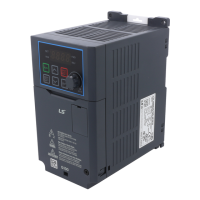Forward direction
retrograde torque limit
Forward direction
regenerative torque
limit
Reverse direction
regenerative torque
limit
Reverse direction
retrograde torque limit
For high-performance operation, the parameters of the motor connected to the inverter
output must be measured. Use auto tuning (bA.20 Auto Tuning) to measure the
parameters before you run sensorless vector operation. To run high-performance
sensorless vector control, the inverter and the motor must have the same capacity. If the
motor capacity is smaller than the inverter capacity by more than two levels, control may
be inaccurate. In that case, change the control mode to V/F control. When operating with
sensorless vector control, do not connect multiple motors to the inverter output.
5.10.1 Sensorless Vector Control Operation Setting for
Induction Motors
To run sensorless vector control operation, set dr.09 (Control Mode) to 4 (IM
sensorless), select the capacity of the motor you will use at dr.14 (Motor Capacity),
and select the appropriate codes to enter the rating plate information of the motor.
Input (Motor Rating Plate Information)
Efficiency
(when no information is on the rating plate, default values are
used.)

